|
       
> Star Formation
> Life and Death of a star
> Physical Description
> Star Catalogues
> Classification of Stellar Spectra
> Double Stars
> Variable Stars
> Neutron Star
> Black Holes
    
|
A black hole is a
concentration of mass great enough that the force of gravity prevents
anything from escaping from it except through quantum tunneling behavior.
The gravitational field is so strong that the escape velocity near it
exceeds the speed of light. This implies that nothing, not even light, can
escape its gravity, hence the word "black". The term "black hole" is
widespread, even though it does not refer to a hole in the usual sense,
but rather a region of space from which nothing can return.
Black holes are predicted by general relativity. According to classical
general relativity, neither matter nor information can flow from the
interior of a black hole to an outside observer. For example, one cannot
bring out any of its mass, or receive a reflection back by shining a light
source such as a flashlight, or retrieve any information about the
material that has entered the black hole. Quantum-mechanical effects may
allow matter and energy to radiate from black holes; however, it is
thought that the nature of the radiation does not depend on what has
fallen into the black hole in the past.
The existence of black holes in the universe is well supported by
astronomical observation, particularly from studying supernovae and X-ray
emissions from active galactic nuclei.
History
The concept of a body so massive that not even light could
escape from it was put forward by the English geologist John Michell in a
1783 paper sent to the Royal Society. At that time, the Newtonian theory
of gravity and the concept of escape velocity were well known. Michell
computed that a body 500 times the radius of the Sun and of the same
density would have, at its surface, an escape velocity equal to the speed
of light, and therefore would be invisible. In his words:
-
"If the semi-diameter of a sphere of the same density as the Sun were to
exceed that of the Sun in the proportion of 500 to 1, a body falling from
an infinite height towards it would have acquired at its surface greater
velocity than that of light, and consequently supposing light to be
attracted by the same force in proportion to its vis inertiae (inertial
mass), with other bodies, all light emitted from such a body would be made
to return towards it by its own proper gravity.
Although he thought it unlikely, Michell considered the possibility that
many such objects that cannot be seen might be present in the cosmos."
In 1796, the French mathematician Pierre-Simon Laplace promoted the same
idea in the first and second edition of his book Exposition du Systeme du
Monde. It disappeared in later editions. The whole idea gained little
attention in the 19th century, since light was thought to be a massless
wave, not influenced by gravity.
In 1915, Einstein developed the theory of gravity called General
Relativity. Earlier he had shown that gravity does influence light. A few
months later, Karl Schwarzschild gave the solution for the gravitational
field of a point mass, showing that something we now call a black hole
could theoretically exist. The Schwarzschild radius is now known to be the
radius of a non-rotating black hole, but was not well understood at that
time. Schwarzschild himself thought it not to be physical.
In the 1920s, Subrahmanyan Chandrasekhar argued that special relativity
demonstrated that a non-radiating body above a certain mass, now known as
the Chandrasekhar limit (or Chandra's limit), would collapse since there
would be nothing that could stop the collapse. His arguments were opposed
by Arthur Eddington, who believed that something would inevitably stop the
collapse.
In 1939, Robert Oppenheimer and H. Snyder predicted that massive stars
could undergo a dramatic gravitational collapse. Black holes could, in
principle, be formed in nature. Such objects for a while were called
frozen stars since the collapse would be observed to rapidly slow down and
become heavily reddened near the Schwarzschild radius. However, these
hypothetical objects were not the topic of much interest until the late
1960s. Most physicists believed that they were a peculiar feature of the
highly symmetric solution found by Schwarzschild, and that objects
collapsing in nature would not form black holes.
Interest in black holes was rekindled in 1967, due to theoretical and
experimental progress. Stephen Hawking and Roger Penrose proved that black
holes are a generic feature in Einstein's theory of gravity, and cannot be
avoided in some collapsing objects. Interest was renewed in the
astronomical community with the discovery of pulsars. Shortly thereafter,
the use of the expression "black hole" was coined by theoretical physicist
John Wheeler . Prior to that time, the term black star was used
occasionally. The latter term appears in an early episode of Star Trek,
and was still used occasionally after 1967. This is because some people
found the term "black hole" obscene when translated into French or
Russian, for example.
[Top]
Evidence
Formation
General relativity (as well as most other metric theories
of gravity) not only says that black holes can exist, but in fact predicts
that they will be formed in nature whenever a sufficient amount of mass
gets packed in a given region of space, through a process called
gravitational collapse. For example, if you compressed the Sun to a radius
of three kilometers, about four millionths of its present size, it would
become a black hole. As the mass inside the given region of space
increases, its gravity becomes stronger — or, in the language of
relativity, the space around it becomes increasingly deformed. When the
escape velocity at a certain distance from the center reaches the speed of
light, an event horizon is formed within which matter must inevitably
collapse onto a single point, forming a singularity.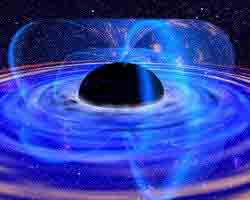
A quantitative analysis of this idea led to the prediction that a star
remaining about three times the mass of the Sun at the end of its
evolution (usually as a neutron star), will almost inevitably shrink to
the critical size needed to undergo a gravitational collapse. Once it
starts, the collapse cannot be stopped by any physical force, and a black
hole is created.
Stellar collapse will generate black holes containing at least three solar
masses. Black holes smaller than this limit can only be created if their
matter is subjected to sufficient pressure from some source other than
self-gravitation. The enormous pressures needed for this are thought to
have existed in the very early stages of the universe, possibly creating
primordial black holes which could have masses smaller than that of the
Sun.
Supermassive black holes containing millions to billions of solar masses
could also form wherever a large number of stars are packed in a
relatively small region of space, or by large amounts of mass falling into
a "seed" black hole, or by repeated fusion of smaller black holes. The
necessary conditions are believed to exist in the centers of some (if not
most) galaxies, including our own Milky Way . [Top]
Observation
In theory, no object past the event horizon could ever
have enough velocity to escape a black hole, including light; due to this,
black holes cannot "emit" any kind of light or evidence that would
otherwise confirm its existence. However, black holes can be inductively
detected from observation of phenomena near them, such as gravitational
lensing and stars that appear to be in orbit around space where there is
no visible matter.
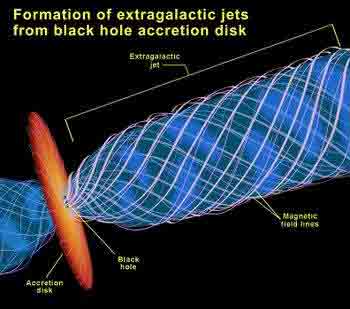
The most conspicuous effects are believed to come from matter falling into
a black hole, which (like water flowing into a drain) is predicted to
collect into an extremely hot and fast-spinning accretion disk around the
object before being swallowed by it. Friction between adjacent zones of
the disk causes it to become extremely hot and emit large amounts of
X-rays. This heating is extremely efficient and can convert about 50% of
the mass energy of an object into radiation, as opposed to nuclear fusion
which can only convert a few percent of the mass to energy. Other
predicted effects are narrow jets of particles at relativistic speeds
squirting off along the disk's axis.
However, accretion disks, jets, and orbiting objects are found not only
around black holes, but also around other objects such as
neutron stars;
and the dynamics of bodies near these non-black hole attractors is largely
similar to the dynamics of bodies around black holes, and is currently a
very complex and active field of research involving magnetic fields and
plasma physics. Hence, for the most part, observations of accretion disks
and orbital motions merely indicate that there is a compact object of a
certain mass, and says very little about the nature of that object. The
identification of an object as a black hole requires the further
assumption that no other object (or bound system of objects) could be so
massive and compact. Most astrophysicists accept that this is the case,
since according to general relativity, any concentration of matter of
sufficient density must necessarily collapse into a black hole.
One important observable difference between black holes and other compact
massive objects is that any infalling matter will eventually collide with
the latter, at relativistic speeds, leading to irregular intense flares of
X-rays and other hard radiation. Thus the lack of such flare-ups around a
compact concentration of mass is taken as evidence that the object is a
black hole, with no surface onto which matter can be suddenly dumped.
[Top]
Have we found them?
There is now a great deal of indirect astronomical
observational evidence for black holes in two mass ranges:
-
stellar mass black holes with masses of a typical star
(4–15 times the mass of our Sun), and
-
supermassive black holes with masses perhaps 1% that of a
typical galaxy
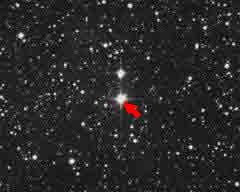 |
|
Location of the X-ray source Cygnus X-1
which is widely accepted to be a 10 solar mass black hole orbiting a
blue giant star |
Additionally, there is some evidence for intermediate-mass
black holes (IMBHs), those with masses of a few thousand times that of the
Sun. These black holes may be responsible for the formation of
supermassive black holes.
Candidates for stellar-mass black holes were identified mainly by the
presence of accretion disks of the right size and speed, without the
irregular flare-ups that are expected from disks around other compact
objects. Stellar-mass black holes may be involved in gamma ray bursts (GRBs),
although observations of GRBs in association with supernovae or other
objects that are not black holes have reduced the possibility of a link.
Candidates for more massive black holes were first provided by the active
galactic nuclei and quasars, discovered by radioastronomers in the 1960s.
The efficient conversion of mass into energy by friction in the accretion
disk of a black hole seems to be the only explanation for the copious
amounts of energy generated by such objects. Indeed the introduction of
this theory in the 1970s removed a major objection to the belief that
quasars were distant galaxies — namely, that no physical mechanism could
generate that much energy.
From observations in the 1980s of motions of stars around the galactic
center, it is now believed that such supermassive black holes exist in the
center of most galaxies, including our own Milky Way. Sagittarius A is now
agreed to be the most plausible candidate for the location of a
supermassive black hole at the center of the Milky Way galaxy. Recent
research has shown that black holes may play a part in the birth and
creation of galaxies.
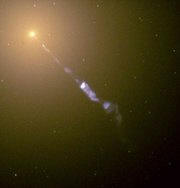 |
The jet emitted by the galaxy M87 in
this image is thought to be caused by a supermassive black hole at
the galaxy's center |
The current picture is that all galaxies may have a supermassive black
hole in their center, and that this black hole swallows gas and dust in
the middle of the galaxies generating huge amounts of radiation — until
all the nearby mass has been swallowed and the process shuts off. This
picture also nicely explains why there are no nearby quasars. Though the
details are still not clear, it seems that the growth of the black hole is
intimately related to the growth of the spheroidal component — an
elliptical galaxy, or the bulge of a spiral galaxy — in which it lives.
Interestingly, there is no evidence for massive black holes in the center
of globular clusters, suggesting that these are fundamentally different
from galaxies.
[Top]
Recent Discoveries
In 2004 a cluster of black holes was detected, broadening
our understanding of the distribution of black holes throughout our
universe. This has led scientists' inferences of how many black holes are
in our universe to be significantly revised. Due to these finds, it is
believed that there are close to five fold the number of black holes than
were previously predicted.
In July 2004 astronomers found a giant black hole, Q0906+6930, at the
center of a distant galaxy in the Ursa Major constellation. The size and
presumed age of the black hole has implications that may determine the age
of the universe.
In November 2004 a team of astronomers reported the discovery of the first
intermediate-mass black hole in our Galaxy, orbiting three light-years
from Sagittarius A. This medium black hole of 1,300 solar masses is within
a cluster of seven stars, possibly the remnant of a massive star cluster
that has been stripped down by the Galactic Centre . This observation may
add support to the idea that supermassive black holes grow by absorbing
nearby smaller black holes and stars.
In February 2005, a blue giant star SDSS J090745.0+24507 was found to be
leaving the Milky Way at twice the escape velocity (0.0022 of the speed of
light). The path of the star can be traced back to the galactic core. The
high velocity of this star supports the hypothesis of a super-massive
black hole in the center of the galaxy.
The formation of micro black holes on Earth in particle accelerators has
been tentatively reported, but not yet confirmed. So far there are no
observed candidates for primordial black holes. Features
and Issues
Black holes require the general relativistic concept of a curved spacetime:
their most striking properties rely on a distortion of the geometry of the
space surrounding them.
[Top]
The Event Horizon
The "surface" of a black hole is the so-called event
horizon, an imaginary surface surrounding the mass of the black hole.
Using the Gauss-Bonnet theorem, Stephen Hawking proved that the topology
of the event horizon of a (four dimensional) black hole is a 2-sphere. At
the event horizon, the escape velocity is equal to the speed of light.
Thus, anything inside the event horizon, including a photon, is prevented
from escaping across the event horizon by the extremely strong
gravitational field. Particles from outside this region can fall in, cross
the event horizon, and will never be able to leave.
According to classical general relativity, black holes can be entirely
characterized according to three parameters: mass, angular momentum, and
electric charge. This principle is summarized by the saying, coined by
John Wheeler, "black holes have no hair".
Objects in a gravitational field experience a slowing down of time, called
time dilation. This phenomenon has been verified experimentally in the
Scout rocket experiment of 1976 [6], and is, for example, taken into
account in the GPS system. Near the event horizon, the time dilation
increases rapidly. From the point of view of an external observer, it
takes an infinite amount of time for an object to approach the event
horizon, at which point the light coming from it is infinitely
red-shifted. To the distant observer, the object, falling slower and
slower, approaches but never reaches the event horizon. The object itself
might not even notice the point at which it crosses the event horizon, and
will do so in a finite amount of proper time. [Top]
The Singularity
At the center of the black hole, well inside the event
horizon, general relativity predicts a singularity, a place where the
curvature of spacetime becomes infinite and gravitational forces become
infinitely strong. Spacetime inside the event horizon is peculiar in that
the singularity is in every observer's future, so all particles within the
event horizon move inexorably towards it (Penrose and Hawking [7]). This
means that there is a conceptual inaccuracy in the nonrelativistic concept
of a black hole as originally proposed by John Michell in 1783. In
Michell's theory, the escape velocity equals the speed of light, but it
would still, for example, be theoretically possible to hoist an object out
of a black hole using a rope. General relativity eliminates such
loopholes, because once an object is inside the event horizon, its
time-line contains an end-point to time itself, and no possible
world-lines come back out through the event horizon.
It is expected that future refinements or generalizations of general
relativity (in particular quantum gravity) will change what is thought
about the nature of black hole interiors. Most theorists interpret the
mathematical singularity of the equations as indicating that the current
theory is not complete, and that new phenomena must come into play as one
approaches the singularity. The question may be largely academic, as the
cosmic censorship hypothesis asserts that there are no naked singularities
in general relativity: Every singularity is hidden behind an event horizon
and cannot be probed.
Another school of thought[8] holds that no singularity occurs, because of
a bubble-like local inflation in the interior of the collapsing star.
Radii stop converging as they approach the event horizon, are parallel at
the horizon, and begin diverging in the interior. The solution resembles a
wormhole (from the exterior to the interior) in a neighborhood of the
horizon, with the horizon as the neck. [Top]
Entering a Black Hole
The effects of a black hole's gravity as described by the Theory of
Relativity cause a number of peculiar effects. An object approaching a
simple Schwarzschild-type (non-rotating) black hole's center will appear
to distant observers as having an increasingly slow descent as the object
approaches the event horizon. This is because a photon takes an
increasingly long time to escape from the pull of the black hole to allow
the distant observer to gain information on the object's fate.
From the object's frame of reference, it will cross the event horizon and
reach the singularity, or center of the black hole, all within a finite
amount of time. Once the object crosses over the event horizon, light will
no longer escape the black hole, and the object can no longer be observed
outside of the black hole. As the object continues to approach the
singularity, it will elongate, and the parts closest to the singularity
will begin to red shift, until they finally become invisible. Nearing the
singularity, the gradient of the gravitational field from head to foot
will become considerable, will stretch and tear because of tidal forces:
the parts closest to the singularity feel disproportionatly stronger
gravitational force than those parts farther away. This process is known
as spaghettification.
[Top]
Rotating black holes
According to theory, the event horizon of a black hole
that is not spinning is spherical, and its singularity is (informally
speaking) a single point. If the black hole ca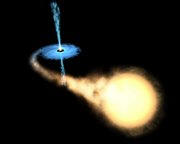 rries
angular momentum (inherited from a star that is spinning at the time of
its collapse), it begins to drag space-time surrounding the event horizon
in an effect known as frame-dragging. This spinning area surrounding the
event horizon is called the ergosphere and has an ellipsoidal shape. Since
the ergosphere is located outside the event horizon, objects can exist
within the ergosphere without falling into the hole. However, because
space-time itself is moving in the ergosphere, it is impossible for
objects to remain in a fixed position. Objects grazing the ergosphere
could in some circumstances be catapulted outwards at great speed,
extracting energy (and angular momentum) from the hole, hence the name
ergosphere ("sphere of work") because it is capable of doing work. rries
angular momentum (inherited from a star that is spinning at the time of
its collapse), it begins to drag space-time surrounding the event horizon
in an effect known as frame-dragging. This spinning area surrounding the
event horizon is called the ergosphere and has an ellipsoidal shape. Since
the ergosphere is located outside the event horizon, objects can exist
within the ergosphere without falling into the hole. However, because
space-time itself is moving in the ergosphere, it is impossible for
objects to remain in a fixed position. Objects grazing the ergosphere
could in some circumstances be catapulted outwards at great speed,
extracting energy (and angular momentum) from the hole, hence the name
ergosphere ("sphere of work") because it is capable of doing work.
[Top]
Entropy and Hawking radiation
In 1971, Stephen Hawking showed that the total area of the event horizons
of any collection of classical black holes can never decrease. This
sounded remarkably similar to the Second Law of Thermodynamics, with area
playing the role of entropy. Classically, one could violate the second law
of thermodynamics by material entering a black hole disappearing from our
universe and resulting in a decrease of the total entropy of the universe.
Therefore, Jacob Bekenstein proposed that a black hole should have an
entropy and that it should be proportional to its horizon area. Since
black holes do not classically emit radiation, the thermodynamic viewpoint
was simply an analogy. However, in 1974, Hawking applied quantum field
theory to the curved spacetime around the event horizon and discovered
that black holes can emit thermal radiation, known as Hawking radiation.
Using the first law of black hole mechanics, it follows that the entropy
of a black hole is one quarter of the area of the horizon. This is a
universal result and can be extended to apply to cosmological horizons
such as in de Sitter spacetime. It was later suggested that black holes
are maximum-entropy objects, meaning that the maximum entropy of a region
of space is the entropy of the largest black hole that can fit into it.
This led to the holographic principle.
Hawking radiation originates just outside the event horizon and, so far as
it is understood, does not carry information from its interior since it is
thermal. However, this means that black holes are not completely black:
the effect implies that the mass of a black hole slowly evaporates with
time. Although these effects are negligible for astronomical black holes,
they are significant for hypothetical very small black holes where
quantum-mechanical effects dominate. Indeed, small black holes are
predicted to undergo runaway evaporation and eventually vanish in a burst
of radiation. Hence, every black hole that cannot consume new mass has a
finite life that is directly related to its mass.
[Top]
Black hole unitarity
An open question in fundamental physics is the so-called information loss
paradox, or black hole unitarity paradox. Classically, the laws of physics
are the same run forward or in reverse. That is, if the position and
velocity of every particle in the universe were measured, we could
(disregarding chaos) work backwards to discover the history of the
universe arbitrarily far in the past. In quantum mechanics, this
corresponds to a vital property called unitarity which has to do with the
conservation of probability.
Black holes, however, violate this rule. Because of the no hair theorem,
we can never determine what went into the black hole. Information is
apparently destroyed, as there is no way to reconstruct what went into the
black hole. This is an important unsolved conceptual problem in quantum
gravity.
On 21 July 2004 Stephen Hawking presented a new argument that black holes
do eventually emit information about what they swallow, reversing his
previous position on information loss. He proposed that quantum
perturbations of the event horizon could allow information to escape from
a black hole, where it can influence subsequent Hawking radiation [9]. The
theory has not yet been reviewed by the scientific community, and if it is
accepted it is likely to resolve the black hole information paradox. In
the meantime, the announcement has attracted a lot of attention in the
media.
[Back] [Top] [Next] |




 rries
angular momentum (inherited from a star that is spinning at the time of
its collapse), it begins to drag space-time surrounding the event horizon
in an effect known as frame-dragging. This spinning area surrounding the
event horizon is called the ergosphere and has an ellipsoidal shape. Since
the ergosphere is located outside the event horizon, objects can exist
within the ergosphere without falling into the hole. However, because
space-time itself is moving in the ergosphere, it is impossible for
objects to remain in a fixed position. Objects grazing the ergosphere
could in some circumstances be catapulted outwards at great speed,
extracting energy (and angular momentum) from the hole, hence the name
ergosphere ("sphere of work") because it is capable of doing work.
rries
angular momentum (inherited from a star that is spinning at the time of
its collapse), it begins to drag space-time surrounding the event horizon
in an effect known as frame-dragging. This spinning area surrounding the
event horizon is called the ergosphere and has an ellipsoidal shape. Since
the ergosphere is located outside the event horizon, objects can exist
within the ergosphere without falling into the hole. However, because
space-time itself is moving in the ergosphere, it is impossible for
objects to remain in a fixed position. Objects grazing the ergosphere
could in some circumstances be catapulted outwards at great speed,
extracting energy (and angular momentum) from the hole, hence the name
ergosphere ("sphere of work") because it is capable of doing work.